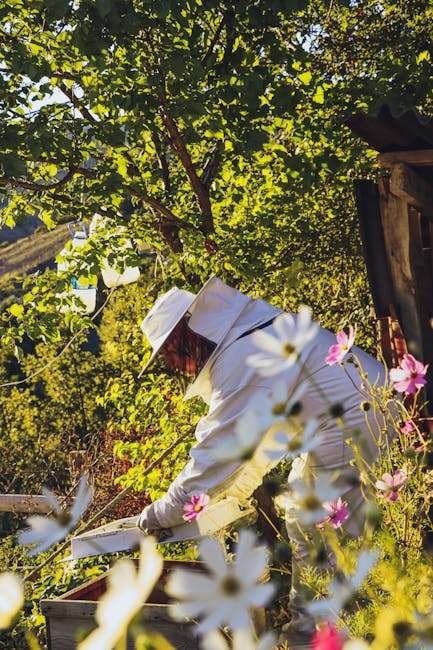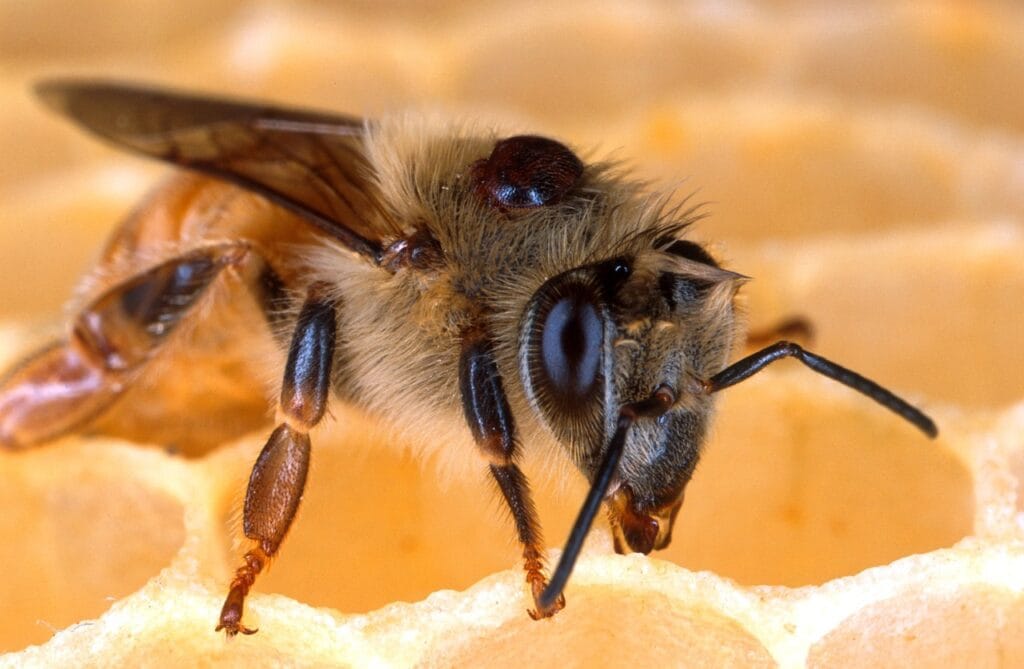Modern beekeeping demands that practitioners serve as comprehensive healthcare providers, environmental managers, and stewards for their colonies.
The beekeeper’s role extends far beyond honey harvesting to encompass critical responsibilities that directly impact colony survival and productivity.
Understanding these multifaceted duties is essential for anyone committed to maintaining healthy, thriving bee populations.
Core Health Management Responsibilities
Disease Prevention and Early Detection
Disease prevention and early detection form the foundation of responsible beekeeping practices.
Beekeepers must conduct regular visual inspections to identify symptoms of major diseases including American foulbrood (which produces a ropy consistency when diseased larvae are probed with a toothpick), European foulbrood (causing larvae to turn yellow-brown and develop a sour odor), Chalkbrood (producing chalk-white, mummified larvae), and Sacbrood (creating water-filled sacs around larvae).
These inspections should occur every 10-14 days during active seasons, with careful attention to brood patterns, bee behavior, and colony odors.[1][2][3][4]
Integrated Pest Management (IPM)
Integrated Pest Management (IPM) represents the modern standard for maintaining colony health.
This systematic approach emphasizes prevention over treatment, utilizing biological, cultural, and chemical controls in a coordinated strategy. IPM requires beekeepers to establish action thresholds—determining when pest populations warrant intervention rather than applying treatments on a predetermined schedule.
For Varroa mites, the most destructive honey bee parasite, treatment thresholds are typically 2-3 mites per 100 adult bees in spring and 3-5 mites per 100 bees in autumn.[5][6][1]
Seasonal Management Practices
Spring Management
Spring management focuses on colony expansion and swarm prevention.
Beekeepers must reverse hive bodies to provide laying space for queens, assess winter food stores (colonies should retain at least 30 pounds of honey), and monitor for swarming preparations.
Spring inspections evaluate queen performance, brood patterns, and population growth, with interventions needed to prevent colonies from dividing before the main honey flow.[7][8]
Summer Operations
Summer months emphasize pest monitoring and honey production optimization.
Varroa mite sampling becomes critical during this period, with beekeepers employing alcohol washes, sugar shakes, or drone brood inspections to assess infestation levels.
Chemical treatments must never be applied while honey supers are present on hives, requiring careful timing of management interventions.[9][1][7]
Autumn Preparation
Autumn preparation centers on winter readiness and final health assessments.
Colonies must be reduced to appropriate size, provided with adequate food stores (60-80 pounds of honey per hive in temperate climates), and treated for Varroa mites using rotated control methods to prevent resistance development.
This season also presents optimal opportunities for requeening operations.[10][8][11][1][7]
Winter Monitoring
In winter monitoring involves minimal intervention but critical oversight.
Beekeepers must ensure proper ventilation, monitor food consumption, and conduct limited inspections only when necessary to avoid disrupting the thermal cluster that bees maintain for survival.[7]
Nutritional Management
Understanding Nutritional Requirements
Knowledge about nutritional requirements enables beekeepers to support colony health during periods of natural scarcity.
Adult honey bees require approximately 11 milligrams of dry sugar daily, translating to roughly 700 pounds of nectar or syrup annually for a 50,000-bee colony.
Protein requirements are met through pollen consumption, with colonies needing approximately 125-312 pounds of pollen annually depending on population size.[12][13][14]
Supplemental Feeding Programs
Feeding honey bees become necessary during nectar and pollen dearths.
Carbohydrates are typically provided as 1:1 sugar syrup in spring for brood stimulation and 2:1 syrup in fall for winter preparation.
Protein supplements should contain 23-30% crude protein and include the ten essential amino acids in proper ratios for optimal utilization.
Beekeepers must be cautious with early spring feeding to prevent overproduction of brood during cold weather periods.[15][14][12]
Equipment and Facility Management
Hive Infrastructure Maintenance
Proper infrastructure maintenance protects colonies from environmental stressors and pests.
This includes installing weather protection features like rain covers and windbreaks, maintaining proper ventilation systems, and ensuring hive stands promote adequate airflow.
Equipment should be positioned to minimize bee drift between colonies while providing morning sun exposure and protection from harsh weather conditions.[16][10]
Sanitation and Sterilization Protocols
Keeping it clean prevents disease transmission between colonies and seasons.
Beekeepers must clean and sterilize hive tools between inspections, replace old darkened comb annually, and properly disinfect equipment using methods such as flame sterilization, bleach solutions (1:5 ratio), or steam cleaning.
American foulbrood contamination requires complete destruction of affected colonies and equipment, as this bacterial disease cannot be cured.[17][18]
Record Keeping and Documentation
Comprehensive Documentation Systems
Keeping comprehensive records enable effective colony management and regulatory compliance.
Essential records include inspection dates and observations, treatment applications and results, queen performance and replacement dates, feeding schedules and quantities, and pest monitoring data.
Many jurisdictions require beekeepers to maintain treatment records for commercial operations or when using prescription medications.[19][20][21]
Legal and Regulatory Compliance
This varies by location but commonly includes apiary registration, location notification requirements, and adherence to best management practices.
In urban areas, beekeepers may need to notify neighbors, maintain specific setback distances, and control swarming to prevent nuisance complaints.
Registration requirements often include annual renewal and associated fees, with penalties for non-compliance.[22][23][24]
Queen Management and Colony Genetics
Queen Health Assessment
Assessing queen health requires beekeepers to evaluate egg-laying patterns, brood development, and pheromone production.
Healthy queens produce 1,000-2,000 eggs daily in consistent patterns, maintain strong pheromone presence that keeps worker bees calm, and exhibit active behavior throughout the hive.
Signs of queen failure include decreased egg production, irregular brood patterns, frequent queen cell construction, and worker bee unrest.[25][26]
Requeening Operations
Requeening should be performed annually to maintain colony vigor and reduce swarming tendency.
Younger queens produce stronger pheromones and exhibit better egg-laying performance than aged queens.
Requeening timing is critical, with late summer (September) offering optimal conditions for queen acceptance and winter bee production.[11][27]
Environmental and Chemical Safety
Pesticide Risk Management
Keeping your bees safe from pesticides requires coordination with agricultural operations and careful hive placement.
Beekeepers must register apiaries with notification programs where available, communicate with neighboring landowners about planned applications, and maintain emergency protocols for protecting colonies during spray operations.
Best practices include placing hives away from treated fields with buffer zones and providing alternative water sources to prevent contamination.[28]
Treatment Product Management
Treatment Product Management involves understanding proper application methods, timing restrictions, and resistance prevention strategies. Organic options include formic acid, oxalic acid, and thymol-based products, while synthetic miticides provide higher efficacy but carry greater residue risks.
Treatment rotation prevents resistance development and maintains long-term effectiveness of available control methods.[9][1]
Professional Development and Continuing Education
Knowledge Updates and Skill Development
Learning about beekeeping and honing skills remain essential as beekeeping science advances and new challenges emerge.
Effective beekeepers participate in local beekeeping associations, attend educational programs, and stay current with research findings on colony health management.
Diagnostic services through university extension programs or commercial laboratories provide valuable support for complex health issues.[26]
Networking and Mentorship
Networking and mentorship within the beekeeping community facilitate knowledge sharing and problem-solving.
Experienced beekeepers often serve as mentors for newcomers, while regional associations provide forums for discussing local challenges and successful management strategies.[26]
In Summary
The beekeeper’s role in colony health and wellness encompasses far more than traditional animal husbandry.
It requires understanding complex ecological relationships, implementing sophisticated management strategies, and maintaining vigilant oversight of dynamic biological systems.
Success depends on consistent application of proven practices, continuous learning, and adaptive management based on colony responses and environmental conditions.
Through diligent attention to these responsibilities, beekeepers can maintain productive colonies that contribute to both agricultural pollination services and sustainable honey production while supporting broader ecosystem health.
⁂
- https://content.ces.ncsu.edu/disease-management-and-guidelines-for-the-honey-bee
- https://www.ars.usda.gov/is/np/honeybeediseases/honeybeediseases.pdf
- https://agriculture.vic.gov.au/biosecurity/animal-diseases/honey-bee-pests-and-diseases/field-diagnosis-of-honey-bee-brood-diseases
- https://www.mannlakeltd.com/blog/tips-for-conducting-a-hive-inspection/
- https://txbeeinspection.tamu.edu/beekeepers/integrated-pest-management/
- https://beehealth.uada.edu/assets/pages/beekeepingipm.html
- https://extension.psu.edu/honey-bee-management-throughout-the-seasons/
- http://extension.msstate.edu/publications/colony-growth-and-seasonal-management-honey-bees
- https://beelab.umn.edu/varroa-mites
- https://honestbeeltd.com/faqs/what-are-the-primary-responsibilities-of-a-beekeeper-in-maintaining-hive-health
- https://sfyl.ifas.ufl.edu/agriculture/requeening-a-beehive/
- https://honeybeehealthcoalition.org/wp-content/uploads/2024/01/HBHC-Honey-Bee-Nutrition-Guide-Supplementary-Feeding-Guide-2024.pdf
- https://www.dpi.nsw.gov.au/animals-and-livestock/bees/management/nutrition2/nutritional-requirements-of-honey-bees
- https://utia.tennessee.edu/publications/wp-content/uploads/sites/269/2023/10/W1152.pdf
- https://pollinators.msu.edu/sites/_pollinators/assets/File/FeedingHoneyBees-Final.pdf
- https://honeybeehealthcoalition.org/wp-content/uploads/2019/01/HBHC_Hive_BMPs_v1.0_reduced.pdf
- https://extension.usu.edu/beekeeping/research/cleaning-and-sterilizing-beekeeping-equipment
- https://hiveology.org/blogs/news/cleaning-beekeeping-equipment
- https://thebfarm.com/blogs/news/a-guide-to-record-keeping-for-beekeepers
- http://www.dave-cushman.net/bee/recordkeeping.html
- https://utia.tennessee.edu/publications/wp-content/uploads/sites/269/2023/10/W1151.pdf
- https://www.youtube.com/watch?v=NJTV6tx979k
- https://www.portland.gov/code/13/30
- https://nyc-business.nyc.gov/nycbusiness/description/beekeeper-registration
- https://blythewoodbeecompany.com/blogs/news/queen-bees
- https://pollinators.ces.ncsu.edu/apiculture/queen-disease-clinic/
- https://www.honeybeesonline.com/requeening-a-bee-hive/
- https://honeybeehealthcoalition.org/wp-content/uploads/2021/09/HBHC_beekeeper_flyer_v16.pdf



